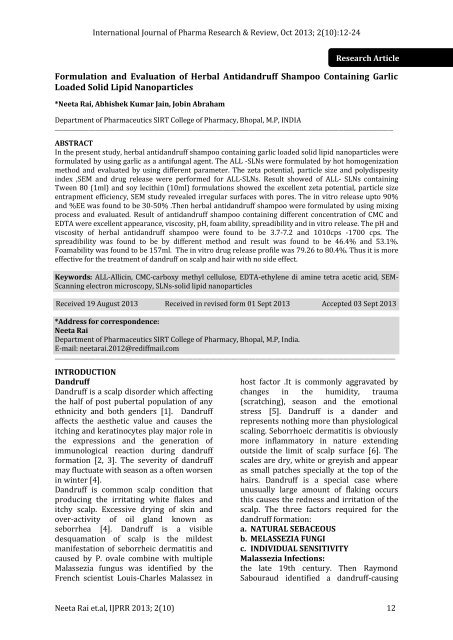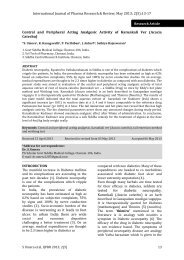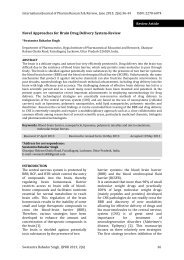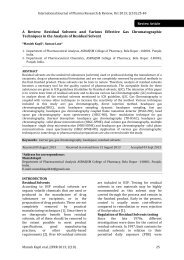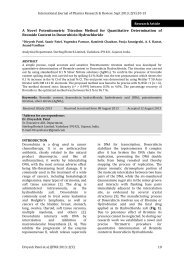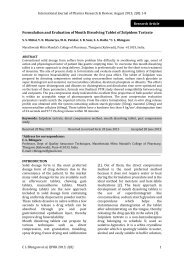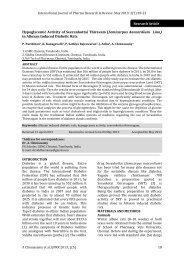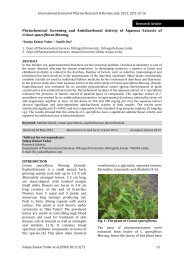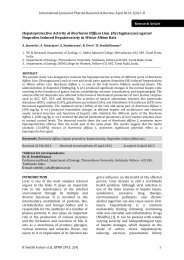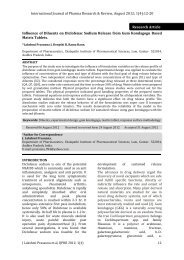Formulation and Evaluation of Herbal Antidandruff Shampoo ...
Formulation and Evaluation of Herbal Antidandruff Shampoo ...
Formulation and Evaluation of Herbal Antidandruff Shampoo ...
- No tags were found...
You also want an ePaper? Increase the reach of your titles
YUMPU automatically turns print PDFs into web optimized ePapers that Google loves.
International Journal <strong>of</strong> Pharma Research & Review, Oct 2013; 2(10):12-24Research Article<strong>Formulation</strong> <strong>and</strong> <strong>Evaluation</strong> <strong>of</strong> <strong>Herbal</strong> Antid<strong>and</strong>ruff <strong>Shampoo</strong> Containing GarlicLoaded Solid Lipid Nanoparticles*Neeta Rai, Abhishek Kumar Jain, Jobin AbrahamDepartment <strong>of</strong> Pharmaceutics SIRT College <strong>of</strong> Pharmacy, Bhopal, M.P, INDIA______________________________________________________________________________________________________________________________________________________ABSTRACTIn the present study, herbal antid<strong>and</strong>ruff shampoo containing garlic loaded solid lipid nanoparticles wereformulated by using garlic as a antifungal agent. The ALL -SLNs were formulated by hot homogenizationmethod <strong>and</strong> evaluated by using different parameter. The zeta potential, particle size <strong>and</strong> polydispesityindex ,SEM <strong>and</strong> drug release were performed for ALL-SLNs. Result showed <strong>of</strong> ALL- SLNs containingTween 80 (1ml) <strong>and</strong> soy lecithin (10ml) formulations showed the excellent zeta potential, particle sizeentrapment efficiency, SEM study revealed irregular surfaces with pores. The in vitro release upto 90%<strong>and</strong> %EE was found to be 30-50% .Then herbal antid<strong>and</strong>ruff shampoo were formulated by using mixingprocess <strong>and</strong> evaluated. Result <strong>of</strong> antid<strong>and</strong>ruff shampoo containing different concentration <strong>of</strong> CMC <strong>and</strong>EDTA were excellent appearance, viscosity, pH, foam ability, spreadibility <strong>and</strong> in vitro release. The pH <strong>and</strong>viscosity <strong>of</strong> herbal antid<strong>and</strong>ruff shampoo were found to be 3.7-7.2 <strong>and</strong> 1010cps -1700 cps. Thespreadibility was found to be by different method <strong>and</strong> result was found to be 46.4% <strong>and</strong> 53.1%.Foamability was found to be 157ml. The in vitro drug release pr<strong>of</strong>ile was 79.26 to 80.4%. Thus it is moreeffective for the treatment <strong>of</strong> d<strong>and</strong>ruff on scalp <strong>and</strong> hair with no side effect.Keywords: ALL-Allicin, CMC-carboxy methyl cellulose, EDTA-ethylene di amine tetra acetic acid, SEM-Scanning electron microscopy, SLNs-solid lipid nanoparticlesReceived 19 August 2013 Received in revised form 01 Sept 2013 Accepted 03 Sept 2013*Address for correspondence:Neeta RaiDepartment <strong>of</strong> Pharmaceutics SIRT College <strong>of</strong> Pharmacy, Bhopal, M.P, India.E-mail: neetarai.2012@rediffmail.com_______________________________________________________________________________________________________________________________________________________INTRODUCTIOND<strong>and</strong>ruffD<strong>and</strong>ruff is a scalp disorder which affectingthe half <strong>of</strong> post pubertal population <strong>of</strong> anyethnicity <strong>and</strong> both genders [1]. D<strong>and</strong>ruffaffects the aesthetic value <strong>and</strong> causes theitching <strong>and</strong> keratinocytes play major role inthe expressions <strong>and</strong> the generation <strong>of</strong>immunological reaction during d<strong>and</strong>ruffformation [2, 3]. The severity <strong>of</strong> d<strong>and</strong>ruffmay fluctuate with season as a <strong>of</strong>ten worsenin winter [4].D<strong>and</strong>ruff is common scalp condition thatproducing the irritating white flakes <strong>and</strong>itchy scalp. Excessive drying <strong>of</strong> skin <strong>and</strong>over-activity <strong>of</strong> oil gl<strong>and</strong> known asseborrhea [4]. D<strong>and</strong>ruff is a visibledesquamation <strong>of</strong> scalp is the mildestmanifestation <strong>of</strong> seborrheic dermatitis <strong>and</strong>caused by P. ovale combine with multipleMalassezia fungus was identified by theFrench scientist Louis-Charles Malassez inhost factor .It is commonly aggravated bychanges in the humidity, trauma(scratching), season <strong>and</strong> the emotionalstress [5]. D<strong>and</strong>ruff is a d<strong>and</strong>er <strong>and</strong>represents nothing more than physiologicalscaling. Seborrhoeic dermatitis is obviouslymore inflammatory in nature extendingoutside the limit <strong>of</strong> scalp surface [6]. Thescales are dry, white or greyish <strong>and</strong> appearas small patches specially at the top <strong>of</strong> thehairs. D<strong>and</strong>ruff is a special case whereunusually large amount <strong>of</strong> flaking occursthis causes the redness <strong>and</strong> irritation <strong>of</strong> thescalp. The three factors required for thed<strong>and</strong>ruff formation:a. NATURAL SEBACEOUSb. MELASSEZIA FUNGIc. INDIVIDUAL SENSITIVITYMalassezia Infections:the late 19th century. Then RaymondSabouraud identified a d<strong>and</strong>ruff-causingNeeta Rai et.al, IJPRR 2013; 2(10) 12
International Journal <strong>of</strong> Pharma Research & Review, Oct 2013; 2(10):12-24organism in 1904 <strong>and</strong> called it"Pityrosporum malassez", honouringMalassez [7].Garlic:Garlic is a bulb belonging to family liliaceae.Garlic bulb has usually pink in colour havingcharacteristics odour with pungent <strong>and</strong>aromatic taste having 1.5-2.5 cm in size [8].Solid lipid nanoparticles (SLNs):Solid lipid nanoparticles (SLNs) are lipidbasedsubmicron colloidal carriers system.Solid lipid nanoparticles possess a solidlipid core matrix that can solubiliseliphophilic molecules. The lipid core isstabilized by surfactants (emulsifiers) .SLNsare composed <strong>of</strong> physiological <strong>and</strong>compatible lipids with a high melting pointas the solid core, which is coated by nontoxic amphiphilic surfactants as the outershell. The nanoparticles are in thesubmicron size range (50-1000 nm) <strong>and</strong> inthe solid state at both body <strong>and</strong> roomtemperatures. SLNs <strong>of</strong>fer unique propertiessuch as small size, large surface area, highdrug loading, the interaction <strong>of</strong> phases atthe interfaces, <strong>and</strong> are attractive for theirpotential to improve performance <strong>of</strong>pharmaceuticals, neutraceuticals <strong>and</strong> othermaterial [9].Aims <strong>of</strong> solid lipid nanoparticles [10, 11]a. Possibility <strong>of</strong> controlled drug releaseb. Increased drug stability.c. High drug pay loadd. No bio-toxicity <strong>of</strong> the carrier.e. Avoidance <strong>of</strong> organic solvents.f. Incorporation <strong>of</strong> liphophilic <strong>and</strong>hydrophilic drugs.<strong>Shampoo</strong>:<strong>Shampoo</strong>s are used not only for cleansingpurpose but also for imparting gloss to hair<strong>and</strong> to maintain their manageability <strong>and</strong>oiliness for hairs. <strong>Shampoo</strong> is generallyused to remove dirt on hair. The dirt isremoved by detergents. <strong>Shampoo</strong>s havesome side effect like drying, irritation oneyes. The drying effect <strong>of</strong> shampoo leavesthe hair too dry <strong>and</strong> it is not h<strong>and</strong>ling bycomb. So it is necessary for conditioning <strong>of</strong>the hair .So these things should be avoidedby shampoo [12, 13].Anti-D<strong>and</strong>ruff <strong>Shampoo</strong>:In this type <strong>of</strong> shampoo it contains somespecific function along with the cleansingaction. <strong>Shampoo</strong> usually containantid<strong>and</strong>ruff agent, other medicinal agentlike vitamins, amino acid, plant extract,antibacterial agent etc [13].MATERIALS AND METHODSGarlic was collected from local market. Soylecithin were obtained from CD finechemicals, tween 80 <strong>and</strong> DisodiumHydrogen Ortho Phosphate were obtainedfrom Suvidinath lab, Sodium LaurylSulphate were obtained from Sulab lab,methanol, acetone, CMC, EDTA wereobtained from Loba Chemie Pvt. Ltd.,Mumbai <strong>and</strong> Potassium di-hydrogen OrthoPhosphate were obtained from Ranken lab.Chlor<strong>of</strong>orm was obtained from QualigensFine Chemical (Mumbai, India) Ltd. Allother chemicals <strong>and</strong> solvents having <strong>of</strong> highanalytical gradation were used in thepresent study.Characterization <strong>of</strong> Garlic extractOrganoleptic study <strong>of</strong> Garlic extract:The samples <strong>of</strong> Garlic extract were studiedfor organoleptic characters such as colour,odour <strong>and</strong> appearance.Solubility <strong>of</strong> Garlic extract in DifferentSolvent:The solubility <strong>of</strong> Garlic extract was checkedin different organic solvent such as organicsolvent, inorganic solvent <strong>and</strong> water.Development <strong>of</strong> analytical method:A. Preparation <strong>of</strong> st<strong>and</strong>ard stocksolutions:St<strong>and</strong>ard stock solutions (100μg/mL) <strong>of</strong>Garlic were prepared separately. 1 mL <strong>of</strong>drug was dissolved in 10 mL <strong>of</strong> distilledwater in 100 mL volumetric flask withshaking <strong>and</strong> then volume was made up tothe mark with same solvent.B. Preparation <strong>of</strong> st<strong>and</strong>ard calibrationcurves <strong>and</strong> selection <strong>of</strong> analyticalconcentration ranges:For Allicin, appropriate aliquots <strong>of</strong> st<strong>and</strong>ardstock solution <strong>of</strong> the drug were transferredto a series <strong>of</strong> 10 mL volumetric flasks. Thevolume was made up to the mark with PBSpH 7.0 to obtain working st<strong>and</strong>ard solutions<strong>of</strong> concentrations <strong>of</strong> 10, 20, 30….50 g/mLThe absorbance’s <strong>of</strong> three replicates <strong>of</strong> theworking st<strong>and</strong>ard solutions <strong>of</strong> eachconcentration were measured at theNeeta Rai et.al, IJPRR 2013; 2(10) 13
International Journal <strong>of</strong> Pharma Research & Review, Oct 2013; 2(10):12-24selected analytical wavelengths. Thest<strong>and</strong>ard calibration curves <strong>of</strong> absorbancevs. concentration were plotted.<strong>Formulation</strong> developmentSelection <strong>of</strong> <strong>Formulation</strong>1. On the basis <strong>of</strong> pH <strong>of</strong> Skin for diffusionThe pH <strong>of</strong> the skin is found to be6.8.according to this batch lies on range <strong>of</strong>pH <strong>of</strong> skin.2. On the basis <strong>of</strong> viscosity asspreadibilityThe viscosity <strong>of</strong> shampoo is more importantfactor because <strong>of</strong> spreadibility on hairs.Method <strong>of</strong> Preparation <strong>of</strong> Antid<strong>and</strong>ruff<strong>Shampoo</strong>:Preparation <strong>of</strong> phosphate buffersolution:Phosphate Buffer <strong>of</strong> pH 6.8 at 0.2M: -Dissolve 13.872 g <strong>of</strong> potassium dihydrogenphosphate 35.084 g <strong>of</strong> disodium hydrogenphosphate in sufficient water to produce1000 ml.Extraction process <strong>of</strong> garlic:Freshly prepared 500 gm garlic were taken<strong>and</strong> washed with the distilled water. Peeled<strong>and</strong> crushed in a pestle mortar thanhomogenized with the 1000 ml <strong>of</strong>phosphate buffer solution at pH 6.8 withhomogenizer. The homogenates weresqueezed through muslin cloth to removethe large particles. Centrifuged it for 20minutes <strong>and</strong> supernant were collected,filtered, stored at definite temperature <strong>and</strong>residue were discarded. Freshly collectedgarlic extract used for the preparation <strong>of</strong>SLNsTable 1 Compositions <strong>of</strong> different formulations <strong>of</strong> Allicin loaded SLNs:Ingredients GarlicExtract (ml)Soy lecithin(ml)Tween80(ml)CHCl 3:CH 3OH(ml)Acetone(ml)SLNs1 10 5 0.5 1:1 10SLNs2 10 10 0.5 1:1 10SLNs3 10 15 0.5 1:1 10SLNs4 10 5 1.0 1:1 10SLNs5 10 10 1.0 1:1 10SLNs6 10 15 1.0 1:1 10SLNs7 10 5 1.5 1:1 10SLNs8 10 10 1.5 1:1 10SLNs9 10 15 1.5 1:1 10PREPARATION OF SLNs:The SLNs were prepared by hothomogenization method.i. Formation <strong>of</strong> lipid layer:Lecithin was dissolved in 10 ml <strong>of</strong> acetone.Organic solvent were completely removedby using vacuum rotatory evaporator. Thenthe lipid layer was dissolved in a mixture <strong>of</strong>chlor<strong>of</strong>orm: methanol (5ml).ii. Formation <strong>of</strong> aqueous phase:An aqueous phase was prepared bydissolving given amount <strong>of</strong> Tween 80 in a10 ml <strong>of</strong> the garlic extract (Allicin).iii. Mixing process:Both the organic phase <strong>and</strong> aqueous phasewere heated individually at 70 0 c .Thenaqueous solution was mixed to lipidsolution followed by homogenization for 10min by using homogenizer, then furtherultrasonicate for 20 minutes. The garlicloaded SLNs were obtained by allowingcooling at room temperature.Preparation <strong>of</strong> Antid<strong>and</strong>ruff <strong>Shampoo</strong>:Firstly mixed Allicin loaded SLNs,peppermint oil, lemon oil, carboxy methylcellulose (2% gel), SLS solution <strong>and</strong> made asolution in a non leaching clean glass orstainless steel container. EDTA are mixedin little amount <strong>of</strong> water <strong>and</strong> added into aSLNs containing solution. Add small amount<strong>of</strong> saturated solution <strong>of</strong> Nacl drop wise intoit. Nacl acts as viscosity modifier bycommon ion effect. Add color, perfume <strong>and</strong>pack the shampoo in a suitable containerfor evaluation.Neeta Rai et.al, IJPRR 2013; 2(10) 14
International Journal <strong>of</strong> Pharma Research & Review, Oct 2013; 2(10):12-24Table 2: Composition <strong>of</strong> Antid<strong>and</strong>ruff shampoo containing allicin loaded SLNsIngredientsAllicin-SLNs(%)Lemon Oil(%)PeppermintOil (%)SLS(%)CMC(%)EDTA(%)ColourSH-SLNs1SH-SLNs2SH-SLNs3SH-SLNs4SH-SLNs5SH-SLNs6SH-SLNs7SH-SLNs86 6 6 6 6 6 6 6 65 4 4 3.5 4 4 3 4 35 5 5 4.5 4 5 4 4 4SH-SLNs957 58 58 59 59 59 60 60 6110.5 9 7.5 8.5 8 10 9.5 10 91 2.5 4 3 3.5 0.5 2 0.5 1.5LightPinkLightPinkLightPinkLightPinkLightPinkLightPinkLightPinkLightPinkLightPinkPerfume Q.S Q.S Q.S Q.S Q.S Q.S Q.S Q.S Q.SSaturated Q.S Q.S Q.S Q.S Q.S Q.S Q.S Q.S Q.SNaclSolutionWater Q.S Q.S Q.S Q.S Q.S Q.S Q.S Q.S Q.S<strong>Evaluation</strong> <strong>of</strong> Allicin loaded solid lipidnanoparticles:a).Measurement <strong>of</strong> zeta potential,particle size <strong>and</strong> poly dispersity index.By using Zetasizer, zeta potential weremeasured .In this method the samples werediluted with aqueous solution to get 50-200kcps <strong>and</strong> pH <strong>of</strong> sample from ranges 6.9-7.2. Zeta potential measurement wascarried at 25 0 C, <strong>and</strong> the electric fieldstrength was 23.2V/cm[14, 15].b) Scanning Electron Microscopy (SEM)The SEM analysis <strong>of</strong> prepared allicin loadedSLN was performed for morphologicalstudies. The formulations were placed in tocircular aluminium stubs using doubleadhesive tape <strong>and</strong> coated with gold in HUS -5 GB vacuum evaporator then it wasobserved in Hitachi S-3000 N SEM havingacceleration voltage <strong>of</strong> 10 Kv <strong>and</strong> amagnification <strong>of</strong> 5000X .[14,15]c) Entrapment efficiencyThe Entrapment efficiency <strong>of</strong> preparedSLNs was determined by measuring theconcentration <strong>of</strong> free drug in a dispersionmedium. It was carried out at least 2 weekafter preparation due to crystallization. Itwas determined by adding 1 ml <strong>of</strong> nanosuspensionin to 4 ml <strong>of</strong> water. Thencentrifuged it for 90 min at 15,000 rpm.Then supernants were examined by UV/Visspectrophotometer with further dilution inwater at 324 nm. The amount <strong>of</strong> free drugwas detected in the filtrate <strong>and</strong> the amount<strong>of</strong> incorporated drug was determined as aresult <strong>of</strong> the initial drug minus. Theentrapment efficiency was calculated by[15, 16].%Entrapment efficiency = W (TOTAL DRUG-FREE DRUG) /W (TOTAL DRUG ADDED) × 100.d) In-vitro drug release <strong>of</strong> allicin loadedSLNs:The in vitro release <strong>of</strong> allicin from differentSLNs dispersions was determined using thedialysis bag diffusion technique. Dialysisbag consists <strong>of</strong> 12,000-14,000 MW cut-<strong>of</strong>f.Prior to the experiment, the membrane waswashed with warm Milli-pore doubledistilled water (70°C) for 1 hrs <strong>and</strong> thenrinsed thrice with Milli-pore water toremove the glycerine. 6 mL <strong>of</strong> suspensionwere placed inside the dialysis bag, tied atNeeta Rai et.al, IJPRR 2013; 2(10) 15
International Journal <strong>of</strong> Pharma Research & Review, Oct 2013; 2(10):12-24both ends <strong>and</strong> dipped in the dissolutionmedium Stirring <strong>of</strong> the medium wasmaintained at 100 rpm using a magneticbead <strong>and</strong> the temperature at 37±0.5°c. Twomillilitres aliquot were withdrawn at presettime intervals <strong>and</strong> replaced by an equalvolume <strong>of</strong> a fresh dissolution medium. Aftersuitable dilution, the sample weredetermined spectrophotometrically bymeasuring the absorbance at 324 nm .Theconcentration <strong>of</strong> Allicin in test samples wascalculated by using the regression equation<strong>of</strong> the calibration curve [14].<strong>Evaluation</strong> <strong>of</strong> Antid<strong>and</strong>ruff herbalshampoo containing Allicin loaded solidlipid nanoparticles:a) Appearance:The appearance <strong>of</strong> the prepared SLNs wasvisually observed in a black <strong>and</strong> whitebackground.b) Viscosity:The viscosity <strong>of</strong> prepared Antid<strong>and</strong>ruffshampoo was determined by viscometer.c) pH testingpH test were performed by using thest<strong>and</strong>ard pH paper [15,16]d) Foaming PropertyBy using cylinder shake method the foamtest determined [17, 18]Procedure1. 50 ml <strong>of</strong> the 1% shampoo solution wasput into 500 ml graduated cylinder thenit is covered with h<strong>and</strong>. Then it is shaken12 times .the total volume <strong>of</strong> the foamcontent after 1 min were recorded.2. Foam volume was calculated. Aftershaking the volume <strong>of</strong> foam at 1 mininterval for 4 minutes were recorded.3. That height <strong>of</strong> the foam reaches at level<strong>of</strong> 150 ml is best acceptable.Foaming properties:The shampoo should possess good foaming<strong>and</strong> cleansing property without damagingthe hair. At the temperature <strong>of</strong> 40-45 0 cperson wash the hair. It is replicated byhair. Safety <strong>of</strong> the product by usingsurfactant they cause irritation. Thevolunteer animal using for the studies.Detection <strong>of</strong> foam height:A = Foam +Water (V1)B = Water Only (V2)e) Spreadibility Testing:1. Spreadibility testing was developed toaccess the spreading properties <strong>of</strong> theLiquids, cosmetics, oils.2. This test method was developed to studythe amount <strong>of</strong> spread <strong>of</strong> a sample.Procedure:1. Put a new sheet <strong>of</strong> aluminium foil on tothe bench.2 .Choose a filter paper type (p5, p2) <strong>and</strong>weigh the sheet as accurately. Record thisweigh as W13. Measure <strong>and</strong> record the total area <strong>of</strong> thefilter paper.4. Record the measurement as A5. Carefully place the filter paper in thecentre <strong>of</strong> the aluminium foil sheet.6. Do not blend, fold or alter the filter paper.it should remain flat.7. Choose liquid, cosmetic oil to be tested.8. Draw several millimetres in to the BD 5mlsyringes9. Hold the syringe over the centre <strong>of</strong> thefilter paper carefully pushes out 20 drops.10. When 20 drops hit filter paper, start atimer or stopwatch to count down for 10min. during 10 min liquid will spread in auniform circular pattern <strong>of</strong> filter paper.11. After 10 min filter paper removed fromthe aluminium foil base <strong>and</strong> cut it withscissors, cut whole saturated portion <strong>of</strong> thefilter paper away from dry section. Forbetter results.12. Measure the diameter <strong>of</strong> the saturatedportion <strong>of</strong> the filter paper. If spread was notperfect circle, then take several diameterreadings around the spread area <strong>and</strong>determine an average diameter. Record themeasurement <strong>of</strong> it.Different methods to determinespreadibilityThere are two methods <strong>of</strong> determining thepercent spread <strong>of</strong> test liquid on the filterpaper. They both the method are independedfrom each other.i. It can be done by comparing thedifferences in dry weight.ii. It can be done by measuring thedifference in dry area [18].f) In-vitro drug release study <strong>of</strong> herbalantid<strong>and</strong>ruff shampooThe in vitro release study <strong>of</strong> the preparedherbal antid<strong>and</strong>ruff shampoo was carriedout using Keshary–Chien (K.C) diffusion cellusing a cellophane membrane in phosphatebuffer pH 6.8 for 24 h. The membrane wasmounted in K.C cell, kept at 37 0 C. TheNeeta Rai et.al, IJPRR 2013; 2(10) 16
International Journal <strong>of</strong> Pharma Research & Review, Oct 2013; 2(10):12-24shampoo was spread on donor side.Phosphate buffer pH 6.8 was used as theacceptor medium, from which samples werecollected at regular intervals for 90 min <strong>and</strong>replaced with the same amount <strong>of</strong> buffer.The drug concentration on the receptorfluid was determined spectrophotometricallyat 324 nm <strong>and</strong> calculated by using theregression equation <strong>of</strong> the calibration curve[19].RESULTS AND DISSCUSIONPREFORMULATION STUDIESTable 3: Organoleptic study <strong>of</strong> garlic extractsS.No Specification Garlic ExtractRemarks1 Appearances Liquid2 Colour Pale Yellow3 Taste Pungent4 Odour CharactersticsOdourAnalyte the concentration range:calibration curve for Allicin:After studying the UV spectra <strong>of</strong> allicin, itwas found that they show maximumabsorbance at 324 nm respectively. Soabsorbance at <strong>and</strong> 324.0 nm wasconsidered as λmax for Allicin. TheCharacterization <strong>of</strong> Garlic extracts(Allicin)Organoleptic propertiesThe sample <strong>of</strong> Garlic extract (Allicin) wasfound to be pale yellow in color <strong>and</strong> liquidin nature with pungent taste <strong>and</strong>characteristics odour <strong>and</strong> shown on Table3Solubility <strong>of</strong> Garlic Extract:The solubility pr<strong>of</strong>ile <strong>of</strong> the Allicin wasfound that it is soluble in water, alcohol <strong>and</strong>acetone <strong>and</strong> shown on Table 4Table 4: solubility study <strong>of</strong> garlic extractS.No Chemicals(10ml) GarlicExtract (1ml)1 Ethanol Soluble2 Methanol Insoluble3 Chlor<strong>of</strong>orm Insoluble4 Water Soluble5 Acetone Solublecalibration curve for licin in PBS pH 6.8 isshown in Figure 1 the graph <strong>of</strong> absorbancevs. concentration for Allicin was found to belinear in the concentration range <strong>of</strong> 0-10μg/ml at 324nm. The r 2 <strong>of</strong> the calibrationcurve was found to be 0.999 <strong>and</strong> shown onTable 5Table 5: Concentration <strong>and</strong> absorbance values for Allicin in PBS pH 6.8s.no concentration(µg/ml) Absorbance(nm)1 0 0.0002 10 0.0433 20 0.0804 30 0.1235 40 0.1606 50 0.200REGRESSION COEFFIECIENT (r 2 ) 0.999SLOPE 0.003INTERCEPT 0.0016Figure 1: Calibration Curve <strong>of</strong> Allicin in Phosphate Buffer pH 6.8 at λmax 324 nm.Neeta Rai et.al, IJPRR 2013; 2(10) 17
International Journal <strong>of</strong> Pharma Research & Review, Oct 2013; 2(10):12-24<strong>Evaluation</strong> <strong>of</strong> Allicin Loaded Soild lipidnanoparticles:Appearance <strong>of</strong> Allicin loaded Soild lipidnanoparticles:The Appearance <strong>of</strong> Allicin loaded SLNs werefound <strong>of</strong>f white to white in colour <strong>and</strong> liquidto viscous in nature <strong>and</strong> better result wascream in colour <strong>and</strong> liquid in nature.Zeta potential <strong>of</strong> Allicin loaded Soildlipid nanoparticles:The zeta potential <strong>of</strong> Allicin- SLNs wasobserved <strong>and</strong> found to be-36.8Mv to -44.27Mv <strong>and</strong> better quality to be-38.5 mV <strong>and</strong>shown on Table 6Particle Size <strong>of</strong> Allicin loaded Soild lipidnanoparticles: The particle size <strong>of</strong> Allicin-SLNs was found to be 26.27nm to 33.25nm<strong>and</strong> better quality to be 31.11nm <strong>and</strong>shown on Table 6Polydispersity index <strong>of</strong> Allicin loadedSolid lipid nanoparticles:The Polydispersity index <strong>of</strong> Allicin-SLNswas found to be 0.483-0.862 <strong>and</strong> betterresult to be 0.657 <strong>and</strong> shown on Table 6Table 6: Zeta Potential, Particle Size <strong>and</strong> PDIS.no <strong>Formulation</strong> Pdi Particle Size(nm) Zeta Potential(Mv)1 SLNs1 0.483 26.27 -36.8±3.222 SLNs2 0.361 28.64 -36.4±3.763 SLNs3 0.468 28.92 -36.6±4.104 SLNs4 0.633 29.56 -37.1±4.845 SLNs5 0.657 31.11 -38.5±5.166 SLNs6 0.692 31.58 -39.6±5.547 SLNs7 0.735 32.64 -39.8±4.698 SLNs8 0.794 32.82 -42.6±6.359 SLNs9 0.862 33.25 -44.7±7.25The scanning electron microscopy (SEM)Allicin loaded SLNsThe scanning electron microscopy (SEM)Allicin loaded SLNs was performed <strong>and</strong>image was found <strong>and</strong> shown on Figure 2Figure 2: SEM image <strong>of</strong> SLNs5Entrapment Efficiency: The Entrapmentefficiency was calculated by using theformula <strong>and</strong> result were shown on Table 7<strong>and</strong> Figure 3Figure 3: % Ententrapment Efficiency Of Allicin-SLNSNeeta Rai et.al, IJPRR 2013; 2(10) 18
International Journal <strong>of</strong> Pharma Research & Review, Oct 2013; 2(10):12-24Table 7: Entrapment Efficiency <strong>of</strong> Allicin-SLNsS.no Formul Free drug Total drug %EEation content(ml) content (ml)1 SLNs1 0.7 1 302 SLNs2 0.3 1 703 SLNs3 0.3 1 704 SLNs4 0.2 1 805 SLNs5 0.2 1 806 SLNs6 0.4 1 607 SLNs7 0.4 1 608 SLNs8 0.6 1 409 SLNs9 0.5 1 50In vitro drug release <strong>of</strong> Allicin-SLNs:90 min in vitro dissolution study was donefor allicin loaded SLNs formulation <strong>and</strong>following dissolution pr<strong>of</strong>ile was shown ontable no 8 <strong>and</strong> figure 4, 5, 6Table 8: %Cumulative Release <strong>of</strong> <strong>Formulation</strong>sTim%Cumulative release <strong>of</strong> formulatione(miSLNs 1 SLNs 2 SLNs 3 SLNs 4 SLNs 5 SLNs 6 SLNs 7 SLNs 8 SLNs 9n)0 0 0 0 0 0 0 0 0 015 15.33 18.51 23.12 20.36 22.74 19.85 18.55 19.64 20.1730 22.15 30.75 40.5 35.24 38.75 37.21 31.42 32.61 34.4345 47.62 45.12 57.31 53.24 56.79 52.19 49.53 54.12 56.9360 52.13 59.31 62.31 68.4 63.89 60.77 63.45 60.44 65.1475 60.99 75.65 80.75 83.94 84.52 81.95 76.34 73.42 84.8190 74.77 83.35 92.64 94.3 95.81 93.33 84.24 80.11 92.34Figure 4: In-vitro Drug Release <strong>of</strong> Allicin-SLNs <strong>Formulation</strong> 1, 2, 3Neeta Rai et.al, IJPRR 2013; 2(10) 19
International Journal <strong>of</strong> Pharma Research & Review, Oct 2013; 2(10):12-24Figure 5: In-vitro drug release <strong>of</strong> Allicin-SLNs formulation 4, 5, 6Figure 6: In-vitro drug release <strong>of</strong> Allicin-SLNs formulation 7, 8, 9<strong>Evaluation</strong> <strong>of</strong> Allicin Loaded Solid lipidnanoparticles:Appearance The Appearance <strong>of</strong> herbalAntid<strong>and</strong>ruff shampoo was visuallyobserved <strong>and</strong> found to be fade in colour<strong>and</strong> gelly in nature to pink in colour butmore gelly in nature <strong>and</strong> better result wasfound to be pink colour, liquid in natureshown on Table 9Table 9: Physical AppearanceS.No Batches Physical Appearances1 SH-SLNs 1 Fade in colour <strong>and</strong> gelly in nature2 SH-SLNs 2 Fade in colour <strong>and</strong> sticky in nature3 SH-SLNs 3 Pink in colour ,but more sticky in nature4 SH-SLNs 4 Pink colour but more viscous5 SH-SLNs 5 Pink Colour, Liquid In Nature6 SH-SLNs 6 Pink colour, but slightly gelly in nature7 SH-SLNs 7 Pink colour but more viscous in nature8 SH-SLNs 8 Pink colour but gel formed9 SH-SLNs 9 Pink colour but more gelly in nature.Neeta Rai et.al, IJPRR 2013; 2(10) 20
International Journal <strong>of</strong> Pharma Research & Review, Oct 2013; 2(10):12-24ViscosityThe viscosity <strong>of</strong> herbal antid<strong>and</strong>ruffshampoo was found to be 1010-1710 cps<strong>and</strong> better result was 1599 cps shown ontable no:10pH test:The pH <strong>of</strong> herbal antid<strong>and</strong>ruff shampoo wasfound to be 3.6-7.2 <strong>and</strong> better result was 6.6shown on table no 10SpreadibilityThe spreadibility <strong>of</strong> herbal antid<strong>and</strong>ruffshampoo was found to be 46.4% <strong>and</strong>53.1%<strong>and</strong> shown on table no 10Calculation:1. Determining percent spread by weight:Firstly the dry filter paper was weighed <strong>and</strong>eliminates any variables like liquid,viscosity or evaporative rate%spread by weight= [(w1-w2)/w1]*100W1=3.252W2=1.74= (3.252-1.74)/3.252*100=1.512/3.252*100=0.464*100=46.4%2. Determining percent spread by area:This method is not exact as weighed method. To determining percent spread by area,Calculate as follows: A1=πr 2=3.14*9.6*9.6=289.38A2=3.14*7**7=153.86%spread by area=(A2/A1)/100=(153.86/289.38)*100=0.531*100=53.1%Foamability test:The Foamability <strong>of</strong> formulation was found to be 157 ml <strong>and</strong> shown on table no 10Calculation: -V1=209 MlAfter 5 Minutes V1 =148V2 = 50 Ml=V1-V2=207-50=157mlTable 10: Viscosity, pH, Foaming Property <strong>and</strong> SpreadibilityS.NO BATCHES VISCOSITY(cps) pH FOAMINGPROPERTY1 SH-SLNs 1 1010cps 3.72 SH-SLNs 2 1040cps 4.63 SH-SLNs 3 1210cps 5.34 SH-SLNs 4 1430cps 5.6 157ml5 SH-SLNs 5 1599 cps 6.66 SH-SLNs 6 1610cps 6.47 SH-SLNs 7 1640cps 6.58 SH-SLNs 8 1690cps 6.89 SH-SLNs 9 1710cps 7.2SPREADIBILITY%spread byweight=46.4%Spread byarea=53.1%Neeta Rai et.al, IJPRR 2013; 2(10) 21
International Journal <strong>of</strong> Pharma Research & Review, Oct 2013; 2(10):12-24SLNs were performed <strong>and</strong> shown on tableno 11<strong>and</strong> figure 7,8,9.Time(min)Table 11: In-Vitro Release <strong>of</strong> the Drug <strong>Herbal</strong> Antid<strong>and</strong>ruff <strong>Shampoo</strong> <strong>of</strong> <strong>Formulation</strong>sSHSLNs 1SH-SLNs2In-vitro release <strong>of</strong> the drug herbalAntid<strong>and</strong>ruff shampoo:The In-vitro release <strong>of</strong> the drug herbalAntid<strong>and</strong>ruff shampoo <strong>of</strong> formulations SH-SH-SLNs3%Cumulative release <strong>of</strong> formulationSH- SH- SH- SLNs SH- SLNsSLNs 4 SLNs 5 67SH-SLNs 8SH-SLNs90 0 0 0 0 0 0 0 0 015 27.24 26.41 27.77 24.32 31.22 29.42 23.41 28.34 26.130 37.94 38.72 41.22 45.21 48.94 47.85 42.64 46.45 45.3145 45.22 43.64 45.15 67.25 68.77 59.34 63.84 66.96 52.1560 66.2 62.74 63.24 76.41 79.24 69.82 73.52 72.34 63.4475 75.33 73.12 75.1 89.45 89.87 71.35 86.33 80.11 73.1990 79.26 83.41 85.11 91.21 94.66 93.25 90 91.43 80.4Figure 7: In-Vitro Release <strong>of</strong> the Drug <strong>Herbal</strong> Antid<strong>and</strong>ruff <strong>Shampoo</strong> <strong>of</strong> <strong>Formulation</strong> 1,2,3Figure 8: In-Vitro Release <strong>of</strong> The Drug <strong>Herbal</strong> Antid<strong>and</strong>ruff <strong>Shampoo</strong> <strong>of</strong> <strong>Formulation</strong>4,5,6Neeta Rai et.al, IJPRR 2013; 2(10) 22
International Journal <strong>of</strong> Pharma Research & Review, Oct 2013; 2(10):12-24Figure 9: In-Vitro Release <strong>of</strong> the Drug <strong>Herbal</strong> Antid<strong>and</strong>ruff <strong>Shampoo</strong> <strong>of</strong> <strong>Formulation</strong> 7, 8,9CONCLUSIONAllicin (which is extracted from garlic)contain antifungal activity <strong>and</strong> it isgenerally used in a home-made preparation.While using the garlic for long term use itinhibited the fungal infection/d<strong>and</strong>ruff.Here the formulation <strong>of</strong> antid<strong>and</strong>ruffshampoo, firstly prepared the allicin loadedsolid lipid nanoparticles. SLNs wereprepared by using hot homogenizationmethod for better control release over thekinetics, very long term stability <strong>and</strong> actualamount <strong>of</strong> drug to be encapsulated. Herethe formulation <strong>of</strong> allicin loaded SLNsprepared by using the soy lecithin, tween80, drug <strong>and</strong> some organic solvent. Soylecithin is used as a phospholipids, Tween80 as a surfactant. Surfactant can act as awetting agent <strong>and</strong> lowering the surfacetension <strong>of</strong> solution. Then it was evaluatedby using zeta potential, particle size, SEM<strong>and</strong> drug loaded capacity to achieve desiredSLNs. Now, Antid<strong>and</strong>ruff shampoo wereprepared by homogenization method, byusing the drug, EDTA, CMC, saturatedsolution <strong>of</strong> Nacl solution, sodium laurylsulphate, peppermint oil, lemon oil etc.sodium lauryl sulphate is used as a nanionic surfactant. Lemon oil is also act as aanti- d<strong>and</strong>ruff agent <strong>and</strong> also act as aperfume. At different concentration <strong>of</strong> SLSwere used for the evaluation parameter thebatches were concluded <strong>and</strong> optimized.Allicin loaded SLNs herbal Antid<strong>and</strong>ruffshampoo was prepared successfully.ACKNOWLEDGEMENTAuthors wish to express their thanks to allfaculty members <strong>and</strong> my friends <strong>of</strong> thecollege for their help <strong>and</strong> co‐operationwhile carrying out this research work.REFERENCES1. Saint D L., The history <strong>of</strong> d<strong>and</strong>ruff <strong>and</strong>d<strong>and</strong>ruff in history, A HOMAGE TORAYMOND SABOURAUD ANN DERMATOLVENEREOL, 1990; 117: 23- 27.2. Gupta A K, Batra R, Bluhm R, Boekhout T,Dawson TL Jr. Skin disease associated withMalassezia species .JOURNAL AM ACADDERMATOL 2004;51:785-98.3. Pitard C F, Xhauflaire E U, PitardG.E,Revisiting d<strong>and</strong>ruff, INTERNATIONALJOURNAL OF COSMETIC SCIENCE 2006;28:311-318.4. Pitard C F, Pitard G E, Klingman A, Seasonalmodulation <strong>of</strong> the sebum excreation,DERMATOLIGICA 1990;181:21-225. Vijayanthi G, Kulkarni C, Abraham A,Kolhapure SA. <strong>Evaluation</strong> <strong>of</strong> antid<strong>and</strong>ruffactivity <strong>and</strong> safety <strong>of</strong> polyherbal hair oil, ANOPEN PILOT CLINICAL TRIAL, THEANTISEPTIC 2004;101(9):368-372.6. Amdt K A, Hsu J T. MANNUAL OFDERMATOLOGICTHERAPEUTICS.LIPPINCOTT WILLIAMS AND WILKINSPHILADELPHIA PA, 2007,7;180-184.7. Saint DL, Klingman AM, Stoudemeyer T J, TheRole <strong>of</strong> resident micro flora in thepathogenesis <strong>of</strong> d<strong>and</strong>ruff, JOURNAL OF SOC.COSMETIC CHEMI. 1988; 40:109-117.8. The medicinal uses <strong>of</strong> garlic/natural holistichealth blog.”NATURAL- HOLISTIC- HEALTH.COM. 2009;06-02.Neeta Rai et.al, IJPRR 2013; 2(10) 23
International Journal <strong>of</strong> Pharma Research & Review, Oct 2013; 2(10):12-249. Michael D. Triplett, Enabling Solid LipidNanoparticles Drug Delivery Technology byInvestigating Improved ProductionTechniques, 2004.10. Melike U, Gulgun Y, INT. J. NANOMEDICINE,2(3), 289-300 (2007).11. Kaur IP , Bh<strong>and</strong>ari,R., Bh<strong>and</strong>ari S.,<strong>and</strong>Kakkur. J. CONT. REL., 127, 97-109 (2008).12. Houli Li, Xiaobin Zhao, Yukun Ma <strong>and</strong>Guangxi Zhai, Ling Bing Li <strong>and</strong> Hong Xiang,Lou. J. CONT. RELEASE, 133, 238-244 (2009).13. Mithal B.M. <strong>and</strong> Saha R.N. A H<strong>and</strong>book <strong>of</strong>Cosmetic Vallabh Prakashan, New Delhi, Firstedition,2002, 110-120.14. Thatipamula RP., Palem CR., Gannu R.,Mudragada S.,Yamsani MR. formulation <strong>and</strong>in vitro characterization <strong>of</strong> domperidoneladed solid lipid nanopaticle <strong>and</strong>nanostructured lipid carriers:jouranlstumesac ir. 2011;(19):23-3215. Griffin j .j.,Corcoran R,F,Akana K.K.,JOURNALOF CHEMISTRY, 54 th ,1977;553-554.16. Sagarin E (editor). Cosmetic science <strong>and</strong>technology. Sydney intersciencepublishers;1957.p.205-218.17. Butler H(editor). Poucher’s perfume,cosmetics <strong>and</strong> soaps.10, kluwer academicpublishers.p.289-306, 555-60118. klevin k .,cosmetics <strong>and</strong> toiletries magazine:2004;119(10):32-35.19. Jain D.K, Darwhekar G, Duttswami K.M,Development <strong>and</strong> evaluation <strong>of</strong> anti d<strong>and</strong>ruffhair styling gel containing fluconazole <strong>and</strong>zinc pyrithione, PHARAMTUTO R,2012:1-5.Neeta Rai et.al, IJPRR 2013; 2(10) 24


